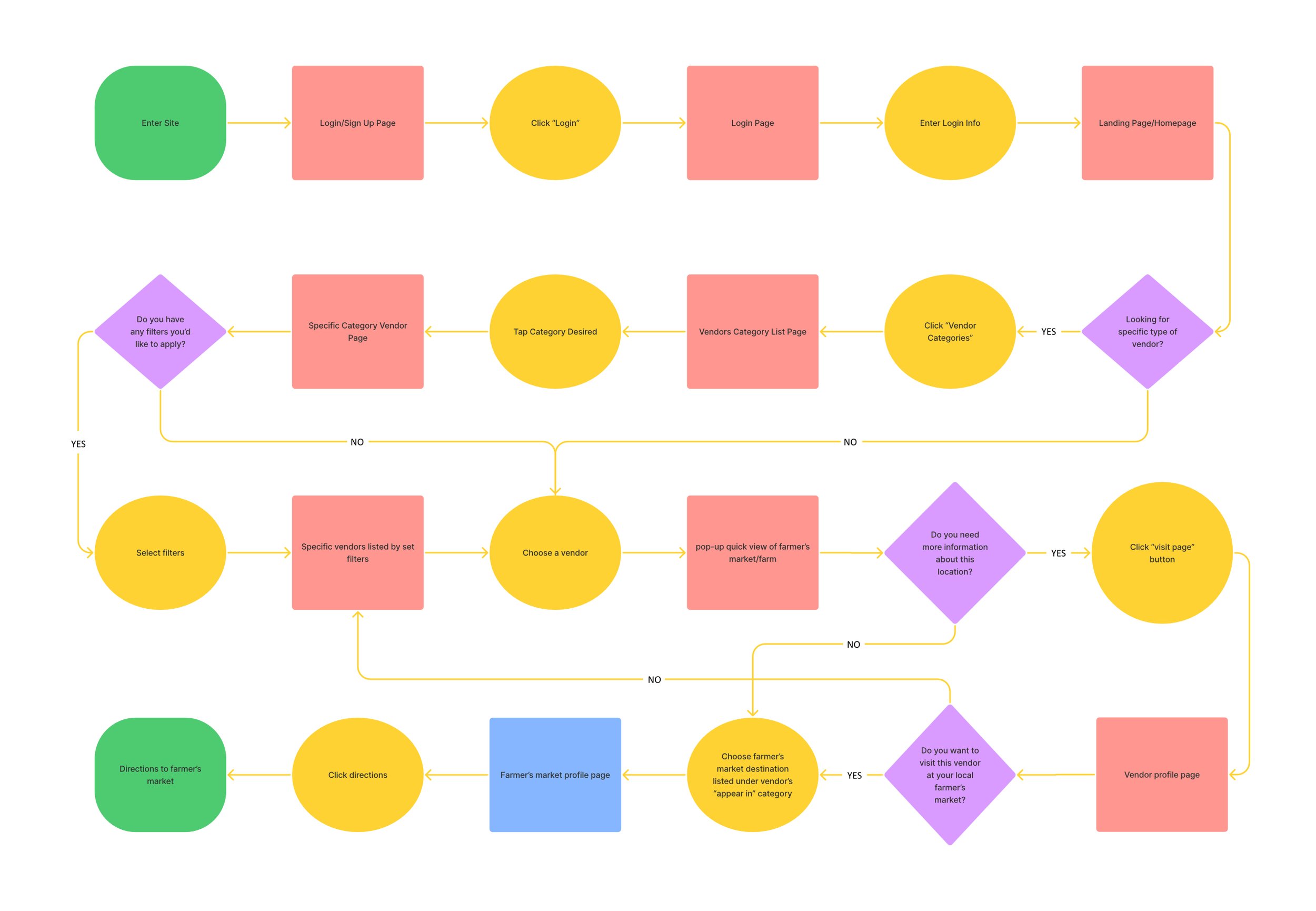Bloom
A native android app case study
There’s nothing like the exhilarating feeling of waking up on a Saturday morning, excited about funnel cakes and fresh produce at your local farmer’s market… only to get there and find out they’re closed that weekend. What a bummer! Bloom is an app designed to help locals find and connect to nearby farmer’s markets and vendors, so that they can continue to support sustainability in their area without the frustrations usually associated with independent markets.
Duration: 1 Month
UX Designer / Project Lead (team of 3)
Tools Used: Affinity Designer, Adobe Photoshop, Figma, Maze, Miro, Google Suite
Inspiration
As we watched store shelves empty and not be restocked until days or weeks later due to staffing shortages during the Covid-19 pandemic, my team began thinking about how our communities shop for groceries, and how people connect to their local community in times of crisis and joy.
What are the fun parts of grocery shopping? What are the awful, stressful parts? Why do people shop where they do, and is there a way for us to bridge gaps in our neighborhoods, even when we can’t help issues in the global supply chain?
Screener Survey
We began by writing a screener survey concerned with asking where people shop and why, and if they could shop somewhere else, where it would be, and why. Our answers were surprising - while many people value convenience highly, they’re also interested in community involvement.
-
100% of respondents are in their early 20’s - early 30’s.
70% identify as female
All respondents currently reside in the U.S.
-
Of our respondents, 85% said that they usually shop at big-name grocery chains.
-
Most of our respondents were concerned with convenience when it came to why they chose a big-name grocery store: 85% responded that the location and hours were convenient for them, while a smaller percentage mentioned that they’re also concerned about price and item selection when choosing a big-name company they trust.
-
Interestingly, while a vast majority of respondents said they preferred big-name stores for convenience, 80% mentioned that if they could shop anywhere, they’d love to support farmer’s markets and local vendors instead of the corporate stores. Several respondents mentioned sustainability and the local economy in their answers, which we found exciting to look into.
Interviews
We followed up with 3 respondents in 1-on-1 interviews, learning more about how and where they did their grocery shopping, how often they went to farmer’s markets, and what they liked or didn’t like about the two experiences. We collected the data into an affinity map, and found that people feel freer to experiment and grow out of their comfort zone when they’re in a place with low expectations and surrounded by others in their community. However, farmer’s markets can also be intimidating and hard to find to those unfamiliar with going. We wondered if there was a way to help bridge this gap.
Persona + Journey Map
Camilla wants to easily find information about farmer’s markets and independent vendors in her area, because she wants to deepen her relationship to her community by supporting sustainable, local businesspeople.
How might we help Camilla access better, more accurate information about local vendors and markets in her area?
User Flow + Mid Fidelity Prototype Testing
Our interviews showed us that while people often go to Farmer’s Markets to wander aimlessly, they’re usually drawn to certain types of food or goods like bread or honey or soap. Our user flow shows a user browsing through vendors like they would at a physical market, specifying which types of goods they’re most excited to see, and then getting more information about where those vendors will regularly show up throughout the market season.
We built our wireframes in Figma, and tested them with Maze, with 6 participants.
-
Task 1: Find a farmer's market that sells honey.
Users told us they needed higher contrast visuals, which we made sure to note for future iterations.
Otherwise, everyone succeeded! Layout and buttons were easy for users to understand.

-
Task 2: Choose a farmer's market near you, and then find out their location and schedule.
After navigating the app flow once, users told us the navigation felt intuitive and clear for this task.

-
Task 3: Connect with your farmer’s market to know about their future events.
Users were confused by “add to favorites” and a heart icon in the app, since the task’s wording was “connect with.” It was an error on our parts, and a good reminder for the importance of clear terminology.

Building Bloom
After our mid fidelity testing, we began fixing the issues users had helped us spot, as well as getting into the aesthetic and design of what a Bloom high-fidelity prototype might look like.
We took a look at actual farmer’s market branding, local gardening clubs, and some small vendors.
High Fidelity Prototype
Created in Figma, our high fidelity prototype of Bloom showcases all of our research:
Connecting users with local vendors and markets that they can get updates on.
Enable users to follow vendors and markets in order to shop from them more regularly.
Our mid fidelity testing showed us where we needed to fix accessibility and terminology issues.
Finally, we were excited to carry through our clear navigation to the final prototype here.










